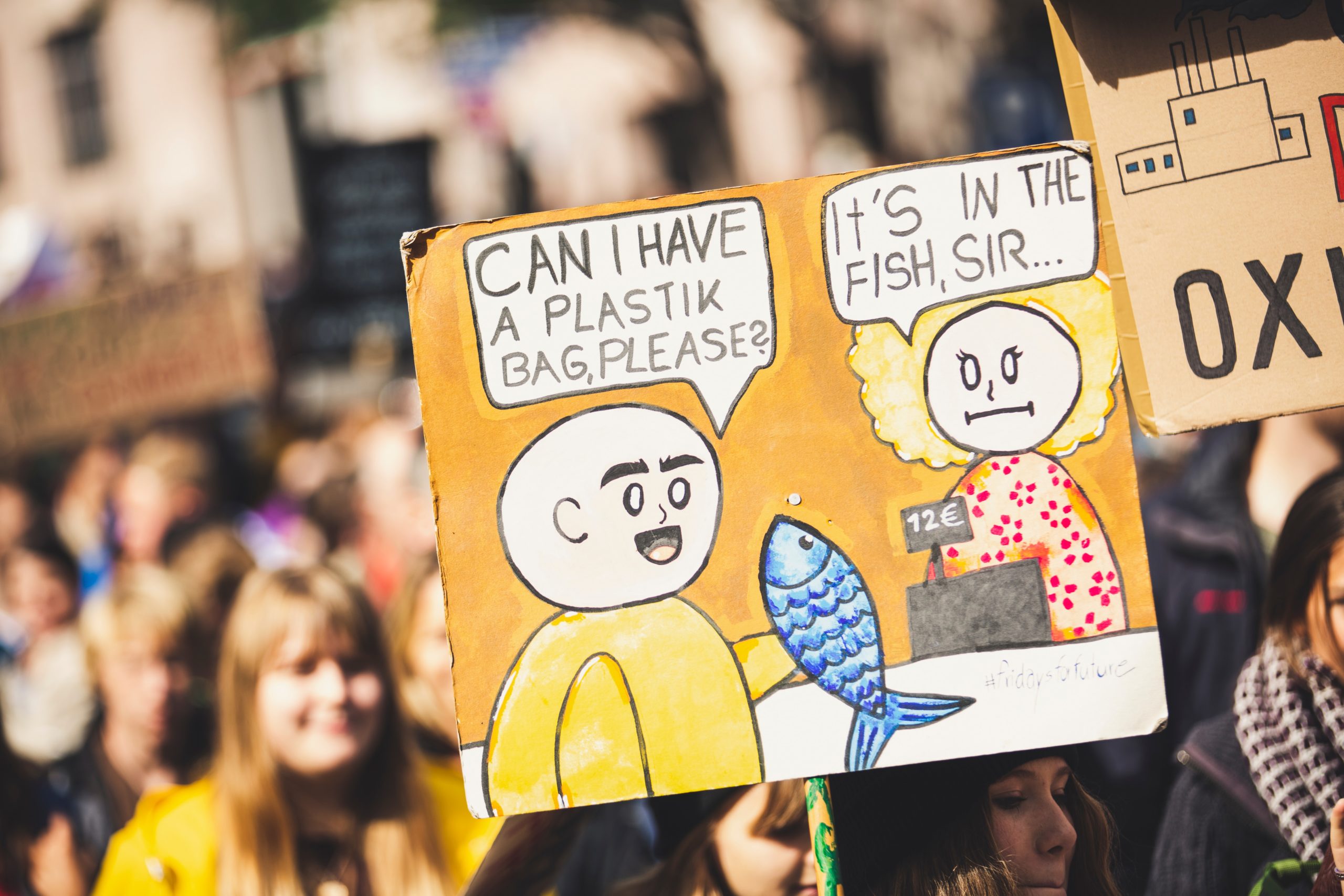
It is well known that the climate crisis is advancing at an alarming level and most people think anything that reduces our carbon footprint should be done to fight against it. Statistics tell us that changing our diet would be one of the most effective ways to do so.
It is well known that the climate crisis is advancing at an alarming level and most people think anything that reduces our carbon footprint should be done to fight against it. Statistics tell us that changing our diet would be one of the most effective ways to do so.

Photo by Markus Spiske
Vegan diet is a plant-based diet that excludes all animal products, meaning meat, egg, and dairy. According to Statista (2021), around two percent of the Dutch population is following this diet. Going further towards the West, the Economist called 2019 ‘The Year of The Vegan’, as many vegetarians decided to switch to a vegan diet. While animal welfare and ethics are shown as the main reasons why people make this decision, the recent increase of the vegan population is mostly attributed to environmentalism, as well as the increased availability of meat and dairy substitutes. A literature review done by Janssen et al. (2016), recorded three main factors that the respondents mentioned as their vegan diet motivation. 89.7% of them had animal-related motives, 69.3% of them mentioned health, and lastly, 46.8% of them stated environment-related issues as their motive. The environment-related motive is interesting as research shows that the emergency of the climate crisis is undebatable, and we should do everything in our power to fight against it. In this case, does switching to a vegan diet really help to reduce climate change and is therefore worth giving a try?
While it is quite popular to blame the cars for high gas emissions, the last report published by the Greenpeace European Unit (2020) states that animal farming in the EU produces more gas emissions than all the European cars combined. The reason behind this is the high cost of animal production. One kilogram of meat generates 20.65 kilograms of CO2 equivalents, and here is how: to be able to produce this one kilogram of beef, we need a ridiculous amount of water. This amount is as high as 15,400 litres when we take the production process into account as well. This process includes water use, especially for growing grains to feed the animals. As for the grains, although it is hard to state an exact number per kilogram of beef, according to the Albert Schweitzer Foundation (2017), 60% of the grains in Germany are used for feeding animals. And it is estimated that one kilogram of meat needs about 2,8 kilograms of grain (Mottet et al., 2017). Moreover, in order to grow all these grains, a large amount of land is needed. The exact amount of required land is difficult to determine as it depends on the feedstuff that is used. However, a combination of studies from different countries concluded that for one kilogram of beef, about 27 to 49 square metres of land is needed (WWF, 2011). Taking Germany as an example, in order to meet the meat demand, an area of 19.000 square kilometers is needed (WWF, 2011). This is roughly the same size as the whole German state Rhineland-Palatinate. Furthermore, this high demand for land is claimed to be the primary reason for deforestation. Especially in South America, producers are deliberately causing fire to make room for agriculture. All in all, animal farming is clearly very harmful for the environment. It has a very high gas emission cost due to the amount of water, grain and land required. Obviously, deforestation is also costly to the environment.
“Vegan diet is the single biggest way to reduce carbon footprints. ”
Despite the emergency of the climate crisis, however, it is still one of the biggest industries because the demand for animal products is quite high. As long as people consume animal products, animal agriculture will remain as a major damage to the environment. One study comparing the carbon footprints of omnivorous, vegan, and vegetarian diets found that the highest footprint was produced by the omnivorous diet (Rosi et al., 2017). To speak with more specific numbers, one study found that cutting the livestock consumption by half in the EU would reduce the greenhouse gas emissions by 25 to 40% (Westhoek et al., 2014). Therefore, giving the vegan diet a chance to save the environment sounds like a great idea indeed.
According to Poore and Nemecek (2019), plant-based diets could reduce the greenhouse gas, acidifying, as well as the eutrophying emissions by up to 73%. Freshwater withdrawals would fall by a quarter and we would also require 78% less farmland. Imagine the contentment we would give to mother nature if we actually cut down the production pressure this much. Thereby, the authors of this paper show the vegan diet as the single biggest way to reduce carbon footprints. One study even concluded that as long as there are no major technological improvements, it is requisite to decrease the meat and dairy consumption in order to reach the 2 Celsius target of the Paris Agreement until 2070 (Hedenus et al., 2014). Considering the aforementioned amount of resources that are needed for meat production, this conclusion is as expected.
So far it can be concluded that animal product consumption is highly damaging to the environment and going vegan can be a great way to put that a break. However, it is still quite difficult to move people out of their comfort zones and make them change their eating habits. Generally, people prefer non-food-related pro-environmental behaviors over cutting meat consumption (Macdiarmid et al., 2016). One of the reasons behind this is the association of meat consumption with social, cultural, and personal values. Many societies have a traditional meat-eating pattern, and this has symbolic and cultural meanings (Leroy and Paret, 2015). One way to overcome this resistance is to produce more alternatives to meat and dairy. Specifically, substitutes that imitate the culture and the taste of animal products as good as possible. With recent technologies, it seems like the producers are doing a good job at this. According to IRI Nederland, the number of plant-based meat substitutes has increased by 51 percent since 2017 in the Netherlands.
“Every step towards reducing the carbon footprint matters.”
To conclude, livestock production is one of the main provokers of the climate crisis. The greenhouse gas emissions, extensive land and water use, as well as the deforestation that is caused by it is highly damaging to the environment. Personally, all the numbers mentioned in this article were beyond my predictions. Sure, it is difficult to change one’s eating habits overnight, but every little step towards reducing the personal carbon footprint matters. Also considering the available substitutes, there is no reason to be scared to make a change in habits, especially one that saves the environment. Hopefully, this article can be a wake-up call to those who care about the environment and want to sustain the world for the future. ‘If not us, then who? If not now, then when?’ <<
References
-Janssen, M., Busch, C., Rödiger, M., & Hamm, U. (2016). Motives of consumers following a vegan diet and their attitudes towards animal agriculture. Appetite, 105, 643-651.
-Mottet, A., de Haan, C., Falcucci, A., Tempio, G., Opio, C., & Gerber, P. (2017). Livestock: on our plates or eating at our table? A new analysis of the feed/food debate. Global Food Security, 14, 1-8.https://albert-schweitzer-stiftung.de/aktuell/1-kg-rindfleisch
-WWF, Meat Eats Land (2011)https://www.wwf.de/fileadmin/fm-wwf/Publikationen-PDF/Meat_eats_land.pdf
-Macdiarmid, J. I., Douglas, F., & Campbell, J. (2016). Eating like there’s no tomorrow: Public awareness of the environmental impact of food and reluctance to eat less meat as part of a sustainable diet. Appetite, 96, 487-493.
-Leroy, F., & Praet, I. (2015). Meat traditions. The co-evolution of humans and meat. Appetite, 90, 200-211.
-Poore, J., & Nemecek, T. (2018). Reducing food’s environmental impacts through producers and consumers. Science, 360(6392), 987-992.
-Rosi, A., Mena, P., Pellegrini, N., Turroni, S., Neviani, E., Ferrocino, I., … & Scazzina, F. (2017). Environmental impact of omnivorous, ovo-lacto-vegetarian, and vegan diet. Scientific reports, 7(1), 1-9.
-Hedenus, F., Wirsenius, S., & Johansson, D. J. (2014). The importance of reduced meat and dairy consumption for meeting stringent climate change targets. Climatic change, 124(1), 79-91.
-Westhoek, H., Lesschen, J. P., Rood, T., Wagner, S., De Marco, A., Murphy-Bokern, D., … & Oenema, O. (2014). Food choices, health and environment: Effects of cutting Europe’s meat and dairy intake. Global Environmental Change, 26, 196-205.
Vegan diet is a plant-based diet that excludes all animal products, meaning meat, egg, and dairy. According to Statista (2021), around two percent of the Dutch population is following this diet. Going further towards the West, the Economist called 2019 ‘The Year of The Vegan’, as many vegetarians decided to switch to a vegan diet. While animal welfare and ethics are shown as the main reasons why people make this decision, the recent increase of the vegan population is mostly attributed to environmentalism, as well as the increased availability of meat and dairy substitutes. A literature review done by Janssen et al. (2016), recorded three main factors that the respondents mentioned as their vegan diet motivation. 89.7% of them had animal-related motives, 69.3% of them mentioned health, and lastly, 46.8% of them stated environment-related issues as their motive. The environment-related motive is interesting as research shows that the emergency of the climate crisis is undebatable, and we should do everything in our power to fight against it. In this case, does switching to a vegan diet really help to reduce climate change and is therefore worth giving a try?
While it is quite popular to blame the cars for high gas emissions, the last report published by the Greenpeace European Unit (2020) states that animal farming in the EU produces more gas emissions than all the European cars combined. The reason behind this is the high cost of animal production. One kilogram of meat generates 20.65 kilograms of CO2 equivalents, and here is how: to be able to produce this one kilogram of beef, we need a ridiculous amount of water. This amount is as high as 15,400 litres when we take the production process into account as well. This process includes water use, especially for growing grains to feed the animals. As for the grains, although it is hard to state an exact number per kilogram of beef, according to the Albert Schweitzer Foundation (2017), 60% of the grains in Germany are used for feeding animals. And it is estimated that one kilogram of meat needs about 2,8 kilograms of grain (Mottet et al., 2017). Moreover, in order to grow all these grains, a large amount of land is needed. The exact amount of required land is difficult to determine as it depends on the feedstuff that is used. However, a combination of studies from different countries concluded that for one kilogram of beef, about 27 to 49 square metres of land is needed (WWF, 2011). Taking Germany as an example, in order to meet the meat demand, an area of 19.000 square kilometers is needed (WWF, 2011). This is roughly the same size as the whole German state Rhineland-Palatinate. Furthermore, this high demand for land is claimed to be the primary reason for deforestation. Especially in South America, producers are deliberately causing fire to make room for agriculture. All in all, animal farming is clearly very harmful for the environment. It has a very high gas emission cost due to the amount of water, grain and land required. Obviously, deforestation is also costly to the environment.
“Vegan diet is the single biggest way to reduce carbon footprints. ”
Despite the emergency of the climate crisis, however, it is still one of the biggest industries because the demand for animal products is quite high. As long as people consume animal products, animal agriculture will remain as a major damage to the environment. One study comparing the carbon footprints of omnivorous, vegan, and vegetarian diets found that the highest footprint was produced by the omnivorous diet (Rosi et al., 2017). To speak with more specific numbers, one study found that cutting the livestock consumption by half in the EU would reduce the greenhouse gas emissions by 25 to 40% (Westhoek et al., 2014). Therefore, giving the vegan diet a chance to save the environment sounds like a great idea indeed.
According to Poore and Nemecek (2019), plant-based diets could reduce the greenhouse gas, acidifying, as well as the eutrophying emissions by up to 73%. Freshwater withdrawals would fall by a quarter and we would also require 78% less farmland. Imagine the contentment we would give to mother nature if we actually cut down the production pressure this much. Thereby, the authors of this paper show the vegan diet as the single biggest way to reduce carbon footprints. One study even concluded that as long as there are no major technological improvements, it is requisite to decrease the meat and dairy consumption in order to reach the 2 Celsius target of the Paris Agreement until 2070 (Hedenus et al., 2014). Considering the aforementioned amount of resources that are needed for meat production, this conclusion is as expected.
So far it can be concluded that animal product consumption is highly damaging to the environment and going vegan can be a great way to put that a break. However, it is still quite difficult to move people out of their comfort zones and make them change their eating habits. Generally, people prefer non-food-related pro-environmental behaviors over cutting meat consumption (Macdiarmid et al., 2016). One of the reasons behind this is the association of meat consumption with social, cultural, and personal values. Many societies have a traditional meat-eating pattern, and this has symbolic and cultural meanings (Leroy and Paret, 2015). One way to overcome this resistance is to produce more alternatives to meat and dairy. Specifically, substitutes that imitate the culture and the taste of animal products as good as possible. With recent technologies, it seems like the producers are doing a good job at this. According to IRI Nederland, the number of plant-based meat substitutes has increased by 51 percent since 2017 in the Netherlands.
“Every step towards reducing the carbon footprint matters.”
To conclude, livestock production is one of the main provokers of the climate crisis. The greenhouse gas emissions, extensive land and water use, as well as the deforestation that is caused by it is highly damaging to the environment. Personally, all the numbers mentioned in this article were beyond my predictions. Sure, it is difficult to change one’s eating habits overnight, but every little step towards reducing the personal carbon footprint matters. Also considering the available substitutes, there is no reason to be scared to make a change in habits, especially one that saves the environment. Hopefully, this article can be a wake-up call to those who care about the environment and want to sustain the world for the future. ‘If not us, then who? If not now, then when?’<<



